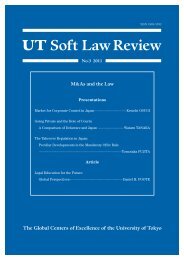UT Soft Law Review
UT Soft Law Review
UT Soft Law Review
You also want an ePaper? Increase the reach of your titles
YUMPU automatically turns print PDFs into web optimized ePapers that Google loves.
<strong>UT</strong> <strong>Soft</strong> <strong>Law</strong> <strong>Review</strong> No.2 2010will. The report also states that it should be decided considering the acquirer’s attribute, theacquisition proposal and the shareholder structure of the target company. The explanationwas persuasive and helped me to get things straight. This is my personal opinion, however,according to this concept, is it possible that the takeover defense can be adopted by the boardas self defense measures, including the issuance of new shares to a third party, only the casewhere the acquirer will damage clearly the corporate value? Especially, when discriminativeallotment of share options without contribution as well as of the issuance of new shares to athird party are used as takeover defense, as I mentioned before, compared to the trend of thejudicial precedents up to Bell System 24 Case, the opinion that the management’s powershould be “limited to the self defense” seems to make the allowance range very narrow.Especially, in the case of temporary restraining order,the procedure called court hearingis taken place intensively two to three times in one or two weeks. In this case, the board ofdirectors has to prove that the other party will clearly destroy the corporate value, in a fewweeks or so. I think this is practically very difficult. Although this is only my inspiration, ingeneral, “the other party will damage the corporate value” and “the abusive acquirer” oftenhave the same meaning, but they would not be always the same. For example, when theacquirer intends to obtain the control over the target company through the abusive method,to obtain the target company’s control premium and to use the corporate asset for ownbenefit, the acquirer would not carry out the acquisition that would damage the corporatevalue. It might be too particular, but that was what I thought about “self-defense.”Fujita: Thank you very much. The report only refers to the “takeover defense measures”and not to the general legitimacy of the issuance of new stocks to a third party, so, once it isdetermined that the main purpose is not for maintaining control power, like Bell System 24Case, it goes beyond the report’s scope. If the purpose of issuing new stock is determinedsuch, the board of directors has the right to manage with its managerial decision – I thoughtthat was the position of this report, but maybe it can be interpreted differently. Mr. Ishiwata,what do you think about this report? Regarding this categorization or classification?Ishiwata: As described before, the report states that “If a takeover defense measure isused for ensuring time, information and negotiation opportunity, there is a possibility that theboard of directors is allowed to implement the defense measure by its decision only. On theother hand, to stop the acquisition by making a substantial decision with respect to theacquisition proposal, it basically requires the decision of the shareholders with a limitedexception in which the board of directors is allowed to implement the defense measures by itsdecision only.” It is true that this classification is mostly consistent with the judicial precedent(although partially different in terms of negotiation opportunity etc.), easy to understand andgood reference for practitioners.However, it is important that, even if you say that the board of directors alone canimplement the defense measure based on the lack of time and information, practically, therequirement to implement the defense measure is further limited by the requirements of58





